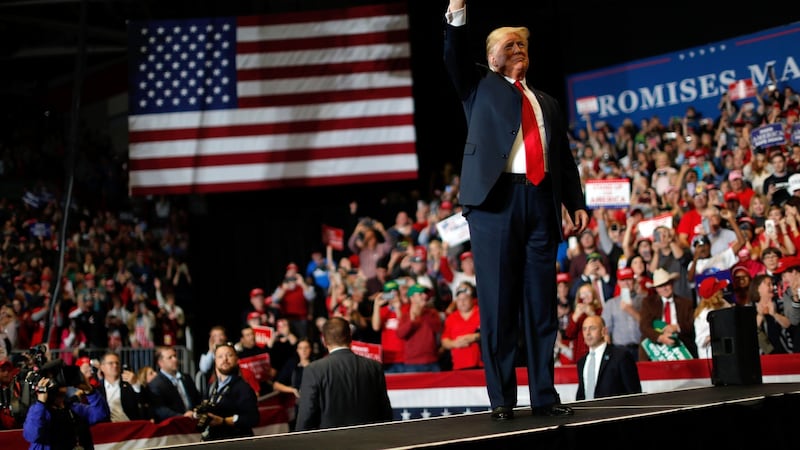Results were beginning to come in on Tuesday night after the US voted at the end of a divisive campaign to decide whether Donald Trump's Republican Party maintains its grip on the US Congress.
The first polls began to close on the east coast at 11pm with analysts predicting a possible record turnout.
More than 31 million votes were already cast before the polls opened at 7am, well ahead of the 22 million early votes cast in the 2014 midterm elections.
Law Enforcement has been strongly notified to watch closely for any ILLEGAL VOTING which may take place in Tuesday’s Election (or Early Voting). Anyone caught will be subject to the Maximum Criminal Penalties allowed by law. Thank you!
— Donald J. Trump (@realDonaldTrump) November 5, 2018
However, severe weather conditions were expected in many east coast states, a factor that could dampen voter turnout.
All 435 seats in the House of Representatives are on the ballot as well as 35 Senate seats and 36 governor positions, including high-profile races in Georgia and Florida.
Democratic senators Bernie Sanders of Vermont, a 2016 presidential contender, and Tim Kaine of Virginia, Hillary Clinton's vice-presidential nominee in 2016, easily won re-election, networks projected. But the crucial senate showdown in Indiana between incumbent Democrat Joe Donnelly and Republican Mike Braun was too close to call with just 4 per cent of the votes in at 12.30am Irish time.
[ [Read Suzanne Lynch’s armchair guide to when to watch and key battles here]Opens in new window ]
Up to 70 House seats are seen as “toss-ups”, meaning they could go either way, though Democrats have been consistently leading in polls. Less certain is the Democrats’ path to the Senate, where the minority party is facing a difficult political map, and is fighting to retain seats in states won by Mr Trump in 2016.
Speaking on the eve of the election, House speaker Paul Ryan said he was "cautiously optimistic" that Republicans could maintain the majority in the House, but he conceded "history is not our friend", noting that midterm elections tend to punish the party of the president in power.
A key demographic will be women voters, with polls showing that women are more likely to vote Democrat than Republican. More than 250 women – a record number – are running for seats in the House and Senate this year.
Trump front and centre
Mr Trump, who has held dozens of rallies in the run-up to the midterms, made a final whistlestop tour of three states on the eve of the election.
Beginning in suburban Cleveland, Ohio where he campaigned for Republican gubernatorial candidate Mike DeWine, the president travelled to Indiana to campaign for Senate candidate Mike Braun, before holding his last rally of the campaign in Missouri, where 38-year-old state attorney general Josh Hawley is taking on incumbent Democratic senator Claire McCaskill.

Speaking at the Ohio rally, he warned that if the “radical Democrats” take power they will “take a wrecking ball to our economy” and “shut down your coal mines and your steel factories”.
“The Democratic agenda is a socialist nightmare for our county – the Republican agenda is an American dream,” he said.
In Indiana, he accused Democrats of “inviting caravan after caravan to pour into our country . . . there is only one way to stop this Democratic assault on American democracy. You have to vote Republican tomorrow.”
In an indication of Mr Trump's continuing belief in his base, he finished his final rally on Monday night with interviews with two conservative media hosts, Sean Hannity of Fox News and radio personality Rush Limbaugh.
According to CNN’s final midterm poll, Mr Trump’s approval rating is at 39 per cent – much lower than any other recent president at this point in the midterm election cycle. Nonetheless the president has put himself front and centre in this election, despite the fact that his presidency is not on the ballot.
While the president focused on three midwestern states on the final day of campaigning, he has stayed away from states where his brand of Republicanism seems to be less popular, such as Arizona and Nevada. Democrats are hoping that those two states offer them an opportunity to win two Senate seats.
Voter fraud
On Sunday, Georgia's secretary of State Brian Kemp announced that his office was investigating Democrats for allegedly trying to hack the state's voter registration files. Mr Kemp is locked in a tight gubernatorial race with Stacey Abrams, the 44 -year-old former state House minority leader who hopes to become the first African-American governor in history. Mr Kemp had already been criticised for perceived conflict of interest – as secretary of state, he is responsible for overseeing the electoral process.
The increasingly bitter tone of the gubernatorial race continued on Monday night, with Mr Kemp accusing Ms Abrams of supporting the New Black Panther party.
Mr Trump, who repeatedly claimed in the wake of the 2016 presidential election that illegal voting had cost him the popular vote, warned against the possibility of fraudulent voting in a tweet on Monday.
“Law Enforcement has been strongly notified to watch closely for any ILLEGAL VOTING which may take place in Tuesday’s Election (or Early Voting),” he tweeted. “Anyone caught will be subject to the Maximum Criminal Penalties allowed by law. Thank you!”
Mr Trump was also heavily criticised for running ads that linked the murder of two police officers in California in 2014 to the caravan of migrants making its way through central America.
Fox News, NBC and Facebook followed CNN and pulled the ads on Monday. NBC had faced a backlash for carrying the ad during a prime time football game on Sunday night.
[ Read Suzanne Lynch’s election night guide hereOpens in new window ]
















